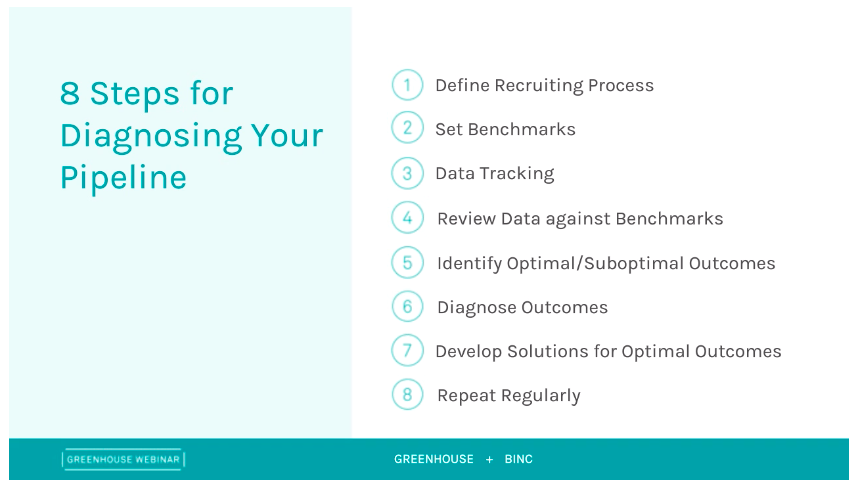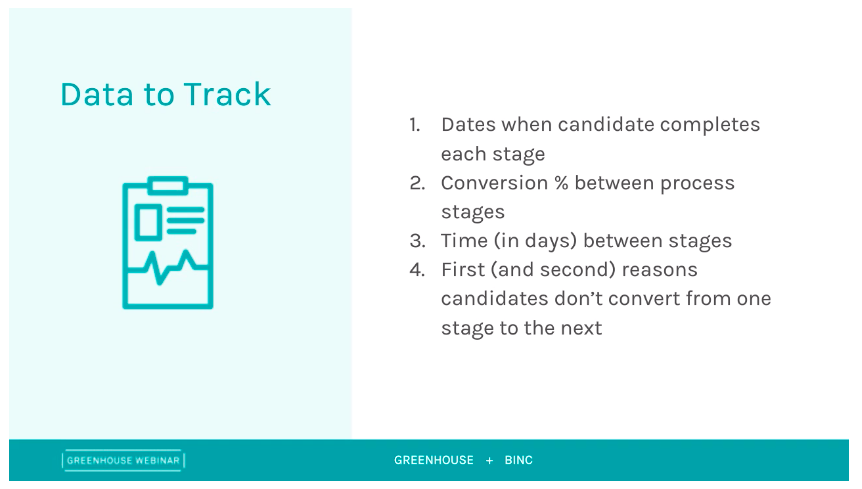How to diagnose your recruiting funnel problems quickly and painlessly

In an ideal world, your recruiting funnel is a well-oiled machine. Your candidate outreach leads to a steady flow of recruiter phone screens, which leads to hiring manager screens, onsite interviews, extended offers and happy new hires. However, for many of us, there’s at least one part of this process that’s a little clunky and not quite as streamlined as we’d like.
James Hunt, Co-Founder of Binc, knows that feeling. He’s worked with over 100 companies – both in-house at Microsoft and Bridgewater Associates and as a consultant at Binc – to help them optimize their recruiting funnels. In the “Diagnosing Your Recruiting Funnel” webinar, he shared some of his tactics and insights. You can watch the full webinar here, or keep reading for a few key points and highlights.

Why is it important to diagnose your recruiting funnel?
James began the conversation with a few reasons why it’s important to monitor and diagnose your recruiting funnel. He compared the recruiting process to a house of cards—there are so many points when a candidate can fall out of the process, either because they opt-out or a company chooses not to move forward with them. But if you’re not keeping tabs on your pipeline, it will be really difficult to identify patterns or shortcomings on your end.
At the same time, recruiting is expensive—whether you’re calculating this based on advertising costs, agency fees, employer branding initiatives, or any other number of factors. The high costs associated with recruiting mean that you want to be able to see a good return on your investment. James advocates for “root cause discovery,” or in other words, understanding exactly what is going wrong and where. Taking this approach means you can generate informed hypotheses and solutions rather than simply guessing about what might not be working.

How to diagnose your recruiting funnel: An 8-step process
Now that we’ve discussed why it’s so important to diagnose your pipeline, how do you actually go about doing it? The chart below outlines James’s recommended process.

Let’s look at the first three steps in more detail.
Step 1: Define your recruiting process
James recommends starting with a well-defined recruiting process. Outline both the core process buckets or what prospects and candidates are experiencing as well as the primary process stages. These stages refer to the activities your company is engaging in such as outbound messaging or recruiter phone screens. Check out the chart below and make adjustments as necessary based on your company’s process.

Step 2: Set benchmarks
Benchmarks provide you with a standard point of reference, giving you a framework to compare and assess your performance against. James recommends focusing on six key conversion rates: from outbound messaging to recruiter phone screen, recruiter phone screen to submission, submission to hiring manager phone screen, hiring manager phone screen to onsite, onsite to offer, and offer to offer accepted.

The benchmarks that James shared in the chart above are based on over 8 years of data and more than 100 companies that Binc has advised. However, James noted that every company is different, so he encourages you to use these benchmarks as a starting off point and adjust them as needed based on your company size, brand recognition and goals.
Step 3: Data tracking
After James outlined which stages you should monitor and shared some benchmarks for each one, he explained which data you should track. It’s important to gather candidate stage completion dates, the conversion percentage between process stages, the time in days between stages and the first and secondary reasons why candidates don’t convert from one stage to the next. This last point is especially important, because it will help you identify problems on your end. For example, the primary reason for a candidate not converting may be that they removed themselves from the process, but the secondary reason could be that they received another offer, which may indicate that your process is moving too slowly.


When closing out the conversation, James focused on three key takeaways. He recommends investing in your candidate value proposition – clearly define what makes your company and this role attractive to candidates. What big problem are you working on? How does this role specifically help solve it? Having a clear candidate value proposition should help you get better results in every stage of the funnel.
Don’t feel like you have to tolerate bad outcomes. When you have a clear recruiting process, data-gathering mechanisms and benchmarks, you should have everything you need to make improvements.
And finally, get to the root cause – dig deeper into the problem areas you identify to try understand what’s really causing these suboptimal outcomes.
To learn more about the rest of the funnel diagnosing process, practice running a few diagnostics yourself and look at some common problem areas and solutions, be sure to watch the full webinar here.
